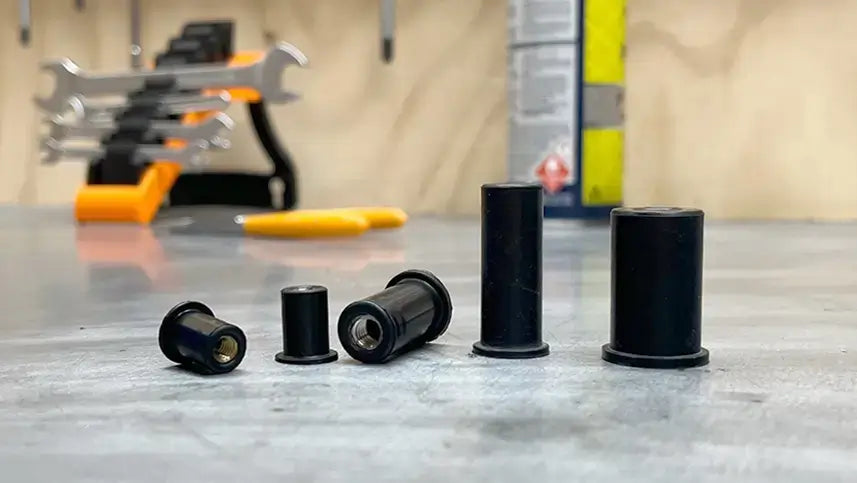Compared with Rivet Nuts & Nutserts in other materials, which “shine on the stage” in the fastener world, Well Nuts seem less appreciated. However, they have their own “personality” and can be used for some applications where regular rivet nuts may not be ideal.
So, what is a Well Nut?
A Well nut, also called a rawlnut or a rubber nut, is a removable rivet nut or nutsert, comprised of an EPDM or Neoprene rubber portion and a brass insert nut.
A Well Nut is a versatile fastening solution that often flies under the radar despite its remarkable functionality. At first glance, it might appear to be just a simple rubber grommet, but it is far more than that. This unassuming rubber component has the power to revolutionise the way you secure objects and materials.
But what exactly is a Well Nut?
In essence, it's a rubber nut with a flanged base and a threaded brass insert. Its unique design allows it to be inserted into a pre-drilled hole in a wide range of materials, providing a secure and vibration-resistant fastening. As the nut is tightened, the rubber expands and forms a watertight seal, making it perfect for applications that require protection against moisture and dust.
Well Nuts come in various sizes and configurations, catering to different load-bearing capacities and environments. From automotive to marine, electronics to construction, this hidden gem of a fastener is a reliable choice. Its ability to distribute loads evenly and dampen vibrations makes it indispensable in scenarios where traditional fasteners might fall short.
Well Nuts are far more than meets the eye. Behind their unassuming appearance lies a world of innovative fastening solutions that can enhance the durability, stability, and longevity of your projects. Whether you're a DIY enthusiast or a professional in need of reliable fasteners, Well Nuts are worth considering for their unique design and exceptional versatility.
Rivet Nuts vs. Well Nuts
Like a regular rivet nut, a well nut can be installed from one side, so it is one of those “blind” fasteners. It has the following benefits:
- No special tools are required for installation – You don’t have to use a rivnut tool to install a well nut, as with other rivet nuts. It can be installed by using a threaded fastener of any type.
- Removable – Removing a regular rivet nut is a pain, but removing a well nut is as easy as loosening the threaded fastener.
- Water-tight – The rubber body is pressed into the pre-drilled hole and deformed tightly at the back of the installation surface after installation. This creates a sealed finish. Though a well nut is water-tight, it doesn’t mean it is waterproof: rubber degradation will eventually occur. The threaded fastener can loosen over time as well.
- Absorbs vibration and noise – Due to the nature of rubber, a well nut can absorb solid transmission sound and reduces vibration effectively.
- Can be used as an insulator – When a well nut is installed, the rubber flange stays between two materials. As a result, there is no galvanic corrosion occurs between the materials.
Due to these benefits, a well nut can be used on glass, pipes, and plywood. It is great for boating and automotive production and maintenance. Well nuts are available in a wide grip range, so they are suitable for both thin and thick plates.
How to Install and Remove Well Nuts
Installing and removing Well Nuts might seem daunting at first, but with the right approach, it's a straightforward process that can greatly enhance the efficiency of your projects. Here's a step-by-step guide on how to install and remove Well Nuts effectively:
Well Nut Installation: Pre Drilled Hole
Choose the Right Size & Grip Range: Select a Well Nut that matches the size of the hole you've drilled. It should fit snugly without being too tight. Make sure the material thickness is within the grip range of the Well Nut.
Insert the Well Nut: Insert the body of the Well Nut (non-flanged part) into the pre-drilled hole.
Tighten Gradually: Using a screwdriver or appropriate tool, start tightening the screw into the threaded insert. As you do this, the rubber nut will compress and expand, creating a watertight seal and secure grip.
Monitor Tightness: Be cautious not to overtighten, as this can damage the Well Nut or the material it's installed in. Stop tightening once you feel resistance.
Well Nut Removal:
Loosen the Screw: Gently loosen the screw from the Well Nut. Avoid applying excessive force.
Remove Carefully: Once the Well Nut is dislodged, carefully pull it out from the hole.
By following these super simple steps, you can confidently install and remove Well Nuts, benefiting from their reliable fastening capabilities and ease of use. Whether you're securing components in a wet environment or reducing vibrations in your projects, Well Nuts are a versatile solution that can simplify your work while delivering robust results.
One thing must be considered about well nuts when choosing a fastener for your job: While a well nut is versatile, its grip relies very much on the deformed rubber body. Therefore, it has a weaker pull-out and torque strength than rivet nuts in other materials. We do not recommend it to be used in structural applications. However, it is reasonably strong, and the following demo video gives you an idea of its performance and how to install and remove it.


